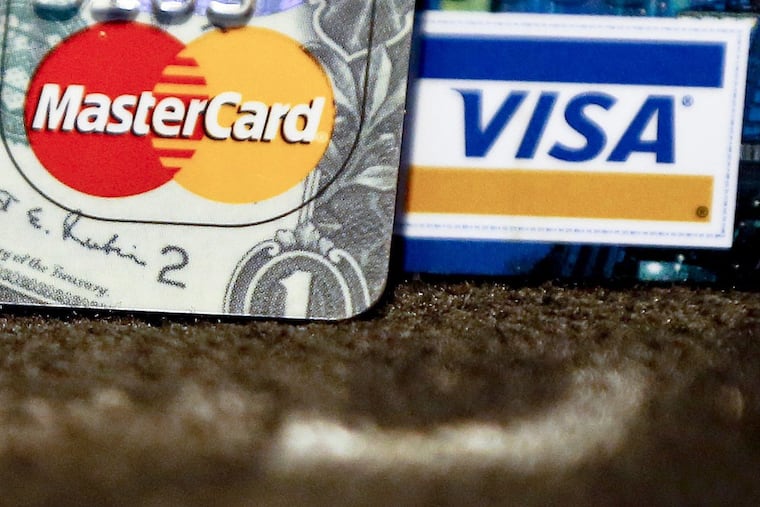How Pa. governments are cutting paperwork, costs, and getting some cash back
More and more local governments and schools are using purchasing cards, or P-Cards, to make paying for services easier and more cost-efficient. P-Cards are a more than $300 billion industry in North America.

Like its 66 counterparts, Bucks County was enduring yet another state budget impasse a few years back and the attendant uncertainty over state funding.
But Bucks didn't even consider cutting social services or depleting its reserves or raising taxes, said Brian Hessenthaler, the county's chief operating officer. In part, that's because it had cut man-hour and paperwork costs by using a purchasing card to pay its bills. And as a bonus, the county received a roughly $250,000 reward over a two-year period for using the electronic payment system.
It's like a personal credit card's "cash back" incentive but on a larger scale.
Just as consumers and corporations have moved to electronic banking and bill paying, more and more local governments and schools are doing the same to make purchases easier and more cost-efficient. For some, this means using a purchasing or procurement card, known as a P-Card.
"We made a concentrated effort to, whenever we could use it, to use it," said Hessenthaler, who is also a board member for the Pennsylvania Local Government Investment Trust, or PLGIT, which sponsors the purchasing card program Bucks uses.
"The P-Card program is a wonderful tool. … Especially in times like this. Taxes are tight. State budgets are tight. Every little bit helps toward the budget."
More than 300 Pennsylvania government entities and school districts, including 72 in Philadelphia's collar counties, now use the PLGIT-sponsored card, which is issued through Harris Bank. The governments and schools pay no fees, and because full payments are due monthly, interest is not an issue.
PLGIT, formed in 1981 to act as an investor for local public agencies, began offering the cards 13 years ago. Philadelphia-based PFM Asset Management manages the trust. PLGIT promoted its P-Card program during the Great Recession "as a way to save money or make money" when interest rates were near zero, said Courtney Mulholland, the director of marketing for PLGIT.
"We used to joke you can make more money using the P-Card than investing money with PLGIT or a bank," she said.
New Jersey started its P-Card program in 1998.
P-Cards have become a more than $300 billion industry in North America, according to the RPMG Research Corp.'s Purchasing Card Benchmark Survey in 2017. Most users are corporations, followed by governments and schools.
Any organization can use a P-Card through a bank of its choosing. Radnor Township, for example, uses TD Bank. As with credit cards, vendors that accept P-Cards pay fees for each transaction. The bank and the credit-card company keep some of the money and redistribute some to users if they spend a certain amount.
Local officials say the purchasing cards also can make paying for items more efficient by reducing the need for invoices, checks, and other paperwork; making auditing easier; reducing opportunities for fraud; and saving time for employees and vendors.
The rebates are a welcome addition.
"You can't leave that money on the table, but it pales in comparison to the saving opportunities," said Diane McGuire, cofounder and managing director of the National Association of Purchasing Card Professionals.
Bucks qualified for its hefty rebate by purchasing supplies and equipment for its $85 million new justice center with its P-Card.
Most rebates are less dramatic. Bucks, for example, gets about $30,000 in a typical year, officials said. In PLGIT's 2017 fiscal year, local agencies received a total of about $525,000.
The first year that Lower Merion Township used its P-Cards, officials charged more than $1 million to the card for equipment and supplies. They got $10,000 back. P-Cards replaced the "more administratively burdensome" accounts payable system two years ago, said Eric Traub, chief financial officer.
P-Cards aren't for everyone, however.
Christopher Berdnik, the Centennial School District's chief financial officer, used P-Cards at another school district he worked in, but does not use them for the district of 5,500 students. The Bucks County district has one credit card that it keeps locked away and uses only when it absolutely must. Otherwise, officials prefer purchase orders and paper checks when buying supplies for the district's six schools. It makes sense for Centennial, Berdnik said.
"There's a trade-off in life between efficiency and internal control," he said.
And anyway, Berdnik said, efficiency isn't a problem for the district. When a school administrator says he or she needs equipment, the district can print a purchase order for it and have the money to the vendor in 24 to 48 hours, just as with a credit or purchase card. As for missing out on a yearly rebate from vendor fees, Berdnik said, "I assure you [vendors] are passing that cost back to you."
Some vendors do ask local governments to pay a fee when using P-Cards. Radnor works only with vendors that do not. The township has never hit the spending threshold to qualify for a rebate but enjoys the streamlined payment process, said William White, assistant township manager and finance director.
TD Bank suggested P-Cards when Radnor officials decided to stop dealing in cash about six years ago in an effort to safeguard against fraud. Using the P-Card, the township has cut down on invoices, not to mention the back-and-forth among departments to get invoice signatures.
"It's minutes per purchase, but … it does add up," White said, adding that the system also saves time on data entry when the township audits purchases.
"As electronic payments become more and more mainstream," White said, "the opportunity for these types of efficiencies will be greater and greater."